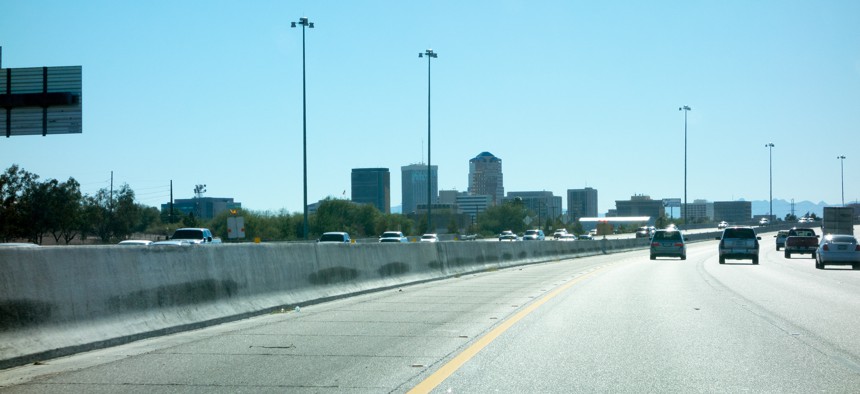The Trump Administration Is Reworking a Multi-Billion Dollar U.S. DOT Grant Program

Interstate 10 running through downtown Tucson, Arizona Shutterstock

Connecting state and local government leaders
Fastlane grants are dead. They’ll be known as Infra grants going forward. But the changes extend beyond the program’s name.
WASHINGTON — The U.S. Department of Transportation on Thursday said it was revamping a major infrastructure grant program, giving higher priority to applicants that can bring bigger shares of non-federal funding to the table for their projects.
The changes have implications for how millions of dollars will flow to transportation projects around the U.S. and would affect what have been known as Fastlane grants.
Established in a 2015 transportation bill, the grants have helped pay for highway and freight infrastructure and officially fall under the so-called Nationally Significant Freight and Highway Projects program.
DOT is renaming Fastlane grants Infrastructure for Rebuilding America, or Infra, grants.
While the same types of projects and costs will be eligible for grant dollars moving forward, the criteria DOT uses to select projects for awards will be different.
“The biggest change is definitely the increased emphasis on financial leverage,” said Jeff Davis, a senior fellow with the Eno Center for Transportation, a nonpartisan think tank.
“This is not really a surprise, because it's been something the administration from the president on down has been talking about as far as their infrastructure plan since the beginning,” he added.
President Trump has voiced support for a new infrastructure spending program that would involve $200 billion in direct federal funding, which could be combined with other sources of money, including private sector investment, to add up to $1 trillion over a decade.
DOT explained in a fact sheet that “leverage” refers “the degree to which a project uses non-federal sources of funding to pay for construction.”
Davis noted that the new selection criteria do “grade on a curve a little bit” for projects in rural and less wealthy areas. “They also specifically say that if you’re using some kind of private equity, you also get a thumbs up, a little plus mark in your evaluation,” he said.
Between fiscal years 2016 and 2020 the grant program is authorized to receive $4.5 billion, according to DOT.
A notice the Transportation Department issued Thursday inviting applicants for the competitive grant program said the agency expects about $710 million of funding will be available during the current fiscal year and $810 million to $855 million in the next budget cycle.
When assessing prospective projects, DOT indicated it will also favor those that might bolster regional or national economic health, or that have the “potential for innovation” when it comes to safety, environmental reviews and permitting, or project delivery.
Speeding up permitting and environmental review processes for infrastructure projects is another priority the Trump administration has identified.
Ten percent of available Infra grants are reserved for “small” projects and must be at least $5 million. The other 90 percent will go to “large” project grants that must be at least $25 million.
Small projects are set to be chosen for the current 2017 fiscal year from applications received in response to a Fastlane notice issued last November, prior to Trump taking office. Applicants seeking large grants will need to submit new materials under the Infra criteria.
The legislation that established the grant program is the Fixing America's Surface Transportation Act, or FAST Act, highway and transit funding legislation that then-President Obama signed in late 2015.
Large Fastlane grants awarded last year include $54 million for improvements on Interstate 10 between Phoenix and Tucson, Arizona and $45 million for railroad upgrades in an area near Seattle’s port. An example of a small grant was $11 million for a rail tunnel rehabilitation project in Oregon at the Port of Coos Bay.
The FAST Act requires at least 25 percent of grant funds awarded through the program now known as Infra to go toward projects in rural areas. Davis pointed out that this proportion of grant awards for rural areas is a floor, rather than a ceiling.
"I would expect the rural percentage of the final program to be significantly higher than 25 percent,” he said.
Davis also highlighted the incongruity that can arise between rural projects and those that are ripe for financial leverage. “To really use leverage you’ve got to have some kind of revenue stream,” he said. In a transportation context this might mean something like highway tolls, which can be tough to implement in sparsely populated areas.
“Seeing the final list is going to be fascinating,” Davis said of the projects that will eventually be selected for Infra grant awards.
Bill Lucia is a Senior Reporter at Government Executive’s Route Fifty and is based in Washington, D.C.

NEXT STORY: Local government's cloud move cuts headaches, adds control





